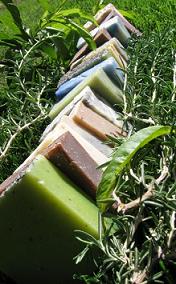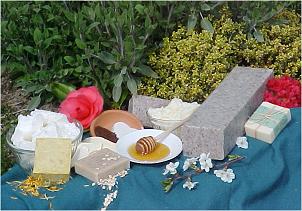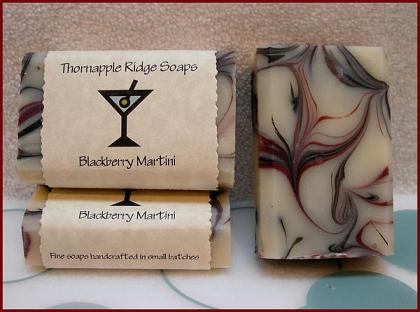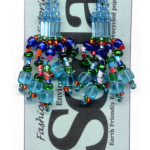 With green living, homeopathy and natural alternatives growing in popularity, soap makers are springing up around the world, concocting magical creations of coconut and lime in gleaming, glycerin-infused goodness that cleanse the body, mind and soul.
With green living, homeopathy and natural alternatives growing in popularity, soap makers are springing up around the world, concocting magical creations of coconut and lime in gleaming, glycerin-infused goodness that cleanse the body, mind and soul.
Oh, and your hands too!
Growing up in my house, ‘handmade’ soap consisted of my mother gathering up all the remaining bits of bar soap from the shower and bathtubs, tossing them into a container with some water and shaking it up. “Voila, hand soap!” she would state proudly. But her objectives were to save money, not create a luxurious lather to soothe and soften the skin. And, trust me, an acrid amalgum of Dial and Irish Spring was anything but soothing!
But today’s handmade soaps are a beneficial blend of nourishing nutrients, rich with essential oils and alleviating aromatherapy that care for the skin and calm the senses. And because they’re chemical-free, they’re an eco-friendly alternative to their caustic counterparts, making them a great way to indulge yourself and the earth.
 If you’re feeling particularly adventurous (and, unlike me, did not blow up the Chemistry lab in high school), you can try your hand at making your own soap at home, which is a fairly simple process of combining lye with some type of fat — anything from plant oil to animal fat — and using water as your catalyst. Remember that lye is a chemical (sodium hydroxide) and is a very strong base so be sure to read the directions very, very carefully and follow them diligently. Again, if you weren’t voted ‘Most Likely to Cause a Chemical Explosion,’ you’ll probably fare just fine but you should always exercise caution when handling combustible materials.
If you’re feeling particularly adventurous (and, unlike me, did not blow up the Chemistry lab in high school), you can try your hand at making your own soap at home, which is a fairly simple process of combining lye with some type of fat — anything from plant oil to animal fat — and using water as your catalyst. Remember that lye is a chemical (sodium hydroxide) and is a very strong base so be sure to read the directions very, very carefully and follow them diligently. Again, if you weren’t voted ‘Most Likely to Cause a Chemical Explosion,’ you’ll probably fare just fine but you should always exercise caution when handling combustible materials.
If you’re ready to brave the elements, the process is simple, and the ingredients are only as far as your grocery store.
What You’ll Need
– 1 small plastic dishpan (10″ x 12″)
– 1 glass or ceramic 2-quart saucepan
– 1 can of lye (12 ounces)
– Fat (1.5 quarts plant/olive/coconut oil, etc.): Different oils will yield different results. Cocount oil, for example, will yield a rich lather whereas olive oil will produce small, silky bubbles. As you get more proficient, you can experiment with different types of ingredients, and add exotic elements like dyes and fragrances.
– Water: Tap water is fine but you may also feel free to use bottled spring water or rain water.*
*rain dance optional
– Plastic gloves (and you should probably wear protective eyewear – especially your first time)
What To Do
– Pour 3 cups of ice cold water (preferably refrigerated overnight) into the 2-quart saucepan
– Slowly and carefully add the lye, a small amount at a time, stirring it with only a plastic or wooden utensil as the mixture will get too hot for a metal object. Be sure to use the plastic gloves and do not breathe in the vapor, lean over the container or have children nearby. (See, making soap is serious business!)
-Allow at least one hour to cool in a safe place. At this time, you can pour your selected oils into the plasttic dishpan.
– Slowly and carefully pour the lye solution into the dishpan with the oils, and mix for at least 15 minutes until it resembles a thick pudding.
– Let it set until the next morning and cut it into bars or any shape that you’d like. (If you’re really creative, you could even use cookie cutters, but you’ll want to keep a separate set for soap and not re-use the same ones for baked goods.)
But if slaving over a hot, chemical mixture is not your idea of a fun afternoon at home, there are a wealth of soap scientists and master sudsmen whipping up bubbly bars of emollient embrocations that are nothing short of works of art.

Plus, their natural essence is chock full of other great benefits:
Give me moisture or give me death.
Commercial, store bought soaps strip out the glycerin so that they can sell it in more expensive cosmetics, which is a natural humectant that holds in moisture, so handmade soaps can make your skin much smoother and more glowing at half the cost and twice the indulgence.
I prefer detergent for my laundry – not my skin.
One of the best things about handmade soaps is that they are 100% chemical- and phosphate-free, and rich in skin-improving ingredients like coconut and palm oil, which are beneficial for the overall health and texture of your skin. They also help protect from harmful pollutants and free radicals, as well as alleviating conditions such as eczema. Best of all, handmade soaps are so mild that they’re gentle enough for the most sensitive skin – even babies.
“Handmade soap, take me away!”
Even better than the skin conditioning benefits are the fragrant botanical oils designed to whisk you away to far off places with their exotic scent. Essential oils like jasmine, lavendar and eucaplyptus offer a spa-quality aromatherapy treatment every time you lather up.
To begin your journey into peace and tranquility that pampers you — and the planet — you can also check out these fine purveyors of soapy serenity:
Thornapple Ridge Soaps – Local specialty shop with innovative original blends like Blackberry Martini, Bay Rum and Rosemary Mint.
Andree’s Essential Soaps Inc. – Their lemon verbena soaps and juicy pink grapefruitTM foaming bath salts made a guest appearance at the Emmy Awards.
Savonnerie Soap | London – Sophisticated yet sustainable soaps for discerning tastes.
Pixie Soap – Unique, handcrafted soaps made with warmth, love and a touch of mischief.
Soap ‘n Scent – A wonderland of organic and zen soap delights — all the way from Thailand.
Whether you choose to get in touch with your wilderness roots by cooking up your own soap, or bask in the flagrant selections of foam craftsmen, your handmade soaps will bring your skin — and the environment — a healing touch that will make washing your hands a whole new experience.

2 Comments